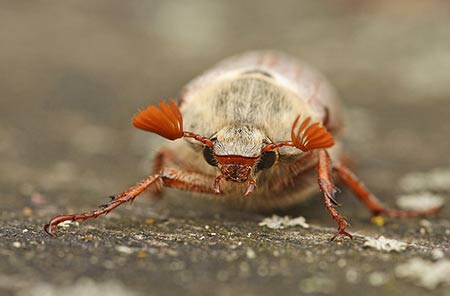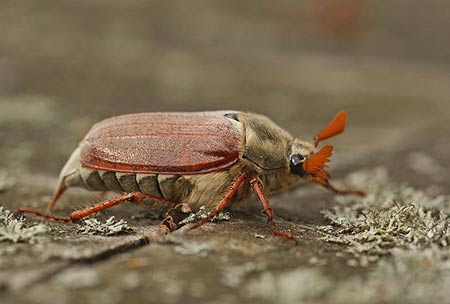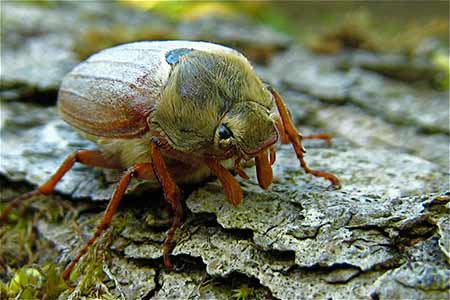Common Cockchafer or May Bug (Melolontha melolontha)
(1) The May Bug's favoured habitats, timing of appearance and relative abundance
When: Late April to July
How many: Fairly abundant and quite widespread within the New Forest National Park

(© Rachel / CC BY-NC-ND 2.0)
(2) Overview
Common Cockchafers, or May Bugs, are huge nocturnal beetles with hairy bodies, reddish-brown wing cases and pointed 'tails' that are typically seen on the wing at dusk and during the hours of darkness.
The name Cockchafer derives from Old English and means 'big beetle', but they are more commonly known as the May Bug as it is during that month that they are often first seen. The flight period, though, depending upon weather conditions, spans late April through to July.
They most often attract attention as they clumsily bang into windows, attracted by lights beyond the glass; fly around street lights; or simply buzz by - they are particularly noisy creatures when in flight as their rapidly beating wings make a loud humming sound.
May Bugs are usually between 2.5 and 3.5 centimetres in length and on warm evenings, attracted by lights, frequently enter houses. Occupants, however, have no need to fear for these creatures are completely harmless and do not sting, bite or do anything else to cause harm to humans. Along with dung beetles, they are members of the scarab family of beetles.

(© Rachel / CC BY-NC-ND 2.0)
They are regarded as common in much of southern England and in the Midlands, but are scarcer farther north. They are typically seen around New Forest villages and in gardens. Anecdotal evidence, however, suggests that abundance, at the very least, varies from year to year, whilst there have been suggestions of population declines over the last 10 years, or so.
(3) Strange, fan-like antennae
May Bugs can certainly lay claim to being one of the strangest-looking creatures likely to be encountered in the New Forest, largely on account of the conspicuous orange, fan-like structures at the end of their antennae, structures that can be opened out at will.
But these are not simply adornments designed to impress other May Bugs or for use during combat or mating rituals, for their purpose is to increase the extent of the sensory area exposed to the surrounding air - it has been suggested that the more complex an insect's antennae, the greater is their sensitivity and also the greater is insect's reliance on them to locate breeding partners by detecting pheromones, find food, identify danger and possibly also to navigate.
Males have seven 'fingers' at the end of their antenna whilst females have six.
(4) Life cycle
As with many other insects, the winged adult life stage is relatively short-lived and amounts to no more than 5 to 6 weeks, although the larvae live underground for 3-4 years before pupating and eventually emerging as adults.

(© Martyn Gorman / cc-by-sa/2.0)
Sometimes known as rookworms, as rooks are said to be particularly fond of them, the larvae are fairly substantially built; creamy-white; and when disturbed, often adopt a curled up, C-shaped posture. They have six legs and reddish-brown heads and grow to between 4 and 4.5 centimetres in length.
(In contrast, superficially similar stag beetle larvae, with which they may be confused, feed on rotted wood; can grow to 8 centimetres in length, and occasionally longer; have an orange head and legs; and are altogether chunkier than May Bug larvae).
Females can lay as many as 80 eggs into the ground, from which larvae hatch and live in the soil, feeding on the roots and tubers of grasses and other plants - in extreme circumstances they can cause significant damage to lawns, grasslands and crops. Adults feed on flowers and the leaves of broad-leaved trees and shrubs, and can sometimes be seen at dusk, buzzing around tree tops before settling to eat.
(5) Predators
A wide range of birds will predate the winged adults, including tawny owls, that have been found to take significant numbers of May Bugs back to the nest to feed to their chicks. Foxes and badgers on the prowl would be unlikely to ignore an upturned May Bug, whilst large bats, such as the Noctule, are also said to catch May Bugs in flight.
And of course humans have not always helped the May Bug. The widespread use of pesticides in the mid-20th century is thought to have significantly reduced the population, although they made something of a comeback since the 1980s; the deliberate killing of May Bugs that enter houses is always a risk; and so are accidental encounters with car windscreens.
But kindly souls can always help these harmless creatures as it is not unusual to encounter an upturned May Bug in need of rescue below a source of light. How they end up on their backs is a bit of a puzzle, but once in that position, they find it difficult to right themselves. Putting them back on their feet is an act of generosity repaid by a feeling of satisfaction as the no-longer-marooned insect flies off into the night.
References:
A photographic guide to Insects of the New Forest and surrounding area: Paul Brock
Natural History Museum
Wildlife Insight
Peoples Trust for Endangered Species
Buglife
RSPB
Handbook of the Birds of Europe, the Middle East and North Africa, The Birds of the Western Palearctic (volumes 1-9): Stanley Cramp, et al
Quick links
More links
Search this site

